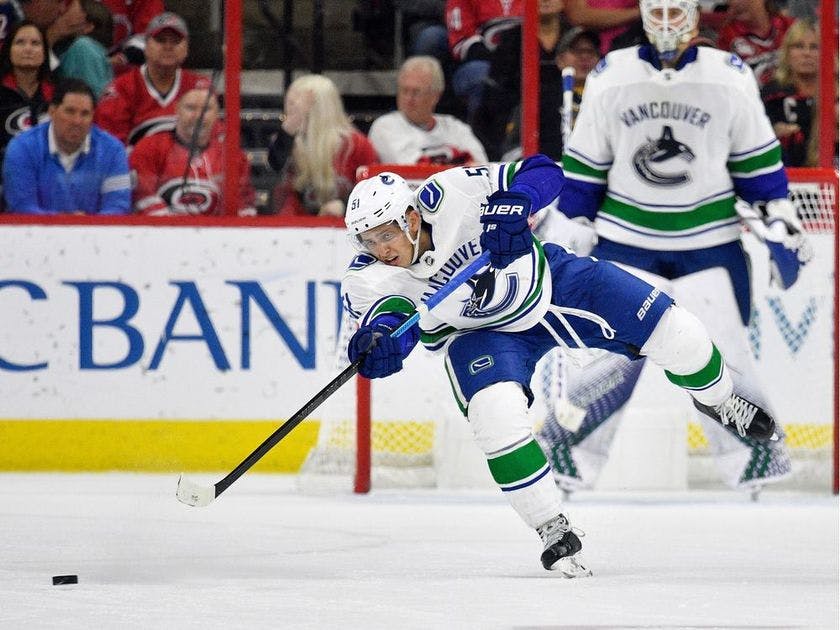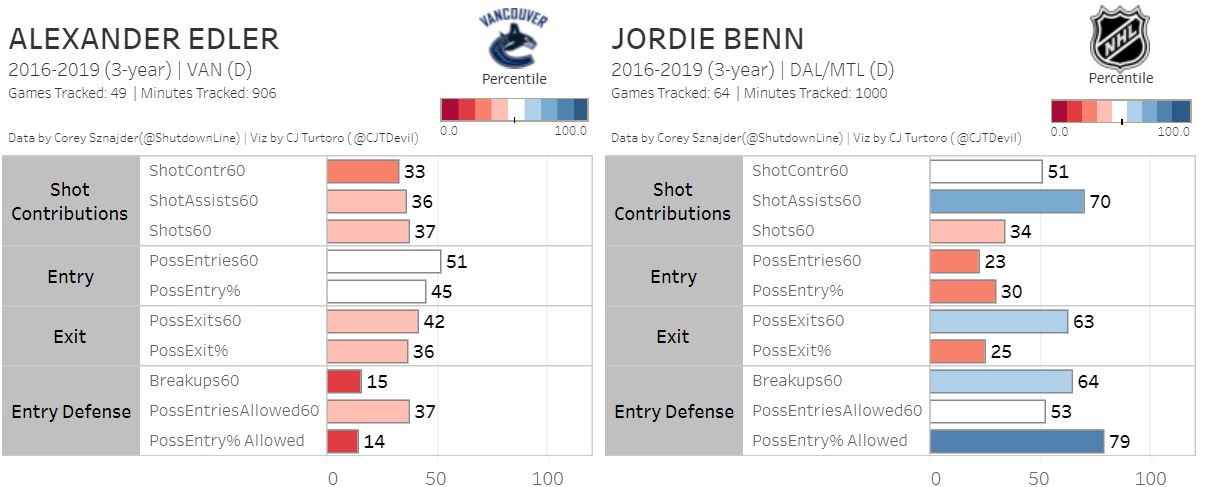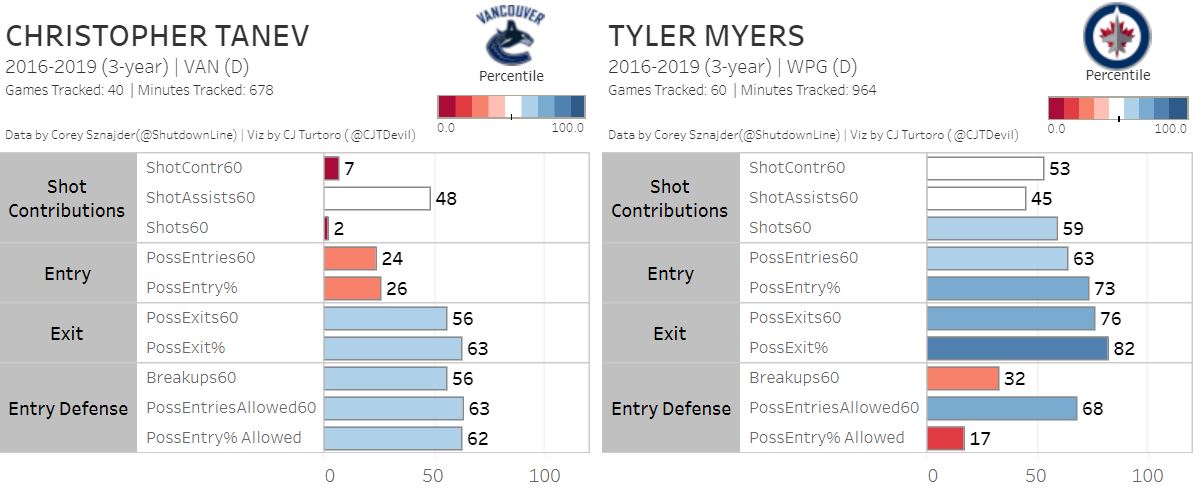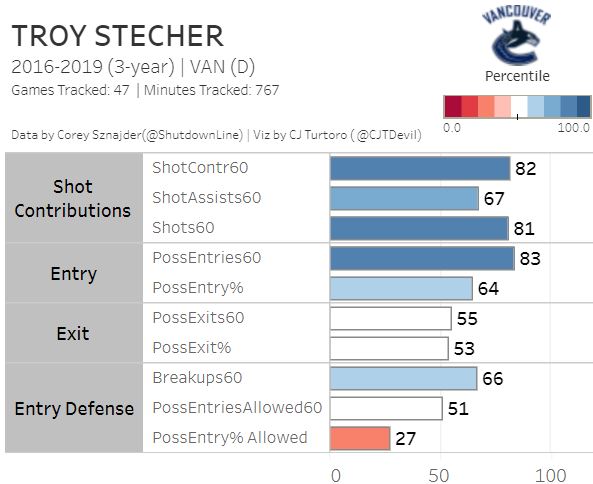Canuck Defencemen in Transition

The starting six on the back end seems to be set and now the focus can shift to figuring out what pairings make the most sense. As a group Canucks defencemen were below league average with their transition play and this will be something they will most certainly need to improve on. The additions of Myers and Benn should help.
Transition play for defencemen speaks more to their ability to create possession exits (out of their own zone) and limit possession entries against (into their own zone) so we’ll focus on that for now.
Possession exits represent instances when a defenceman carries the puck out themselves or makes a pass to a teammate resulting in the puck moving up ice. This is important as we know that pucks moving out and eventually into the offensive zone with possession lead to roughly twice as many goals. Exits that don’t count as possession exits are ones that are dumped out and turned over or go for icing.
Possession entries against represent instances when the opposition carries the puck into your zone with controlled possession. Limiting possession entries against can be done by forcing breakups around the blueline or forcing dump-ins. Keep in mind that breakups are the ideal outcome on defending entries since they result in offsides that halt the rush or turnovers that allow you to counterattack.
Let’s start by taking a look at how the guys on the left side fared over the last 3 years.

Edler’s data may look less favourable that one would have guessed, but it’s important to note the games tracked sample size. We recognize that a 49 game sample size isn’t as much as we would like, but Corey Sznajder notes that defenders stabilize at the 20 game mark, so the data presented is still useful.
Benn’s data gives the opposite impression. For years now, Benn’s entry defence has been underrated and he definitely looks like a defenseman who is worth the $2M. We can see that unlike Edler, he forces a lot of breakups and dump-ins when teams try to carry the puck in on his side.
We don’t have a shot of data for Hughes, but this is one of the times that we can rely on the eye test to assume that he’s above average in his overall transition game based on what we’ve seen so far.


The three on the right side have performed alright over the last 3 years. It should be noted that Tanev’s best year was the 2016/17 season and he hasn’t really been the same since. A massive drop off occurred in his 2017/18 season and he hasn’t really been able to recover.

Stecher has done the opposite and seems to continually round his transition game out. Lastly, Myers is a breakout machine but doesn’t fare as well in the entry defence breakups/60 category.
It was mentioned above that breakups are the ideal outcome for defending entries, and this chart by Sean Tierney nicely shows the group’s ability to force those breakups and create possession exits over the last year.

Replacing the minutes from Pouliot, Gudbranson and Del Zotto with minutes from Hughes, Benn and Myers should improve the team’s ability to create and defend in transition. We may even see a group of six that’s above league average in possession zone exits next year. It will be interesting to see if Benn and Myers can keep up their possession exit percentage playing in a new system.
The breakup percentage could be more of a concern if Edler, Myers, Stecher and maybe even Hughes put up below average breakup percentages. If the percentage of possession entries against is too high as the season goes on, adjustments can be made by the forward group to be harder on the backcheck.
Considering all of this, let’s have some fun and build the pairings that could make the most out of their transition abilities. It’s fair to think that Green will want each pair to move the puck out well and decrease the likelihood of being hemmed in their zone for long stretches. The following 5 on 5 pairs may give them the best chances of doing so:
Edler – Stecher
Hughes – Tanev
Benn – Myers
These pairings would each feature an above average puck mover. It would also spread out those with best breakup percentages in Tanev, Benn and Stecher. Tanev regressing slightly more this year wouldn’t be a surprise, which could leave a Benn – Myers tandem as the best in possession exits. Having them take a good chunk of defensive zone starts to transition the puck up and out wouldn’t be a bad thing.
Based on the group’s numbers last year, Green has reason to be concerned about his back end controlling play in transition on both sides of the puck. Setting these pairs would be a good response to those concerns. With half of the group playing their first full year in Canuck sweaters, we will see a lot of mixing and matching to figure out who fits best with who, but this is a good place to start.
Recent articles from Michael Wagar





